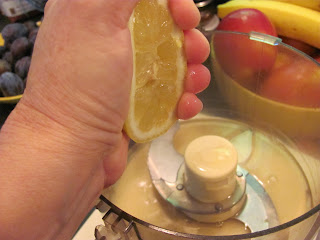
For as long as I can remember I've heard that
Parmigiano Reggiano was the king of cheeses. It's the cheese I ate in Italy and cooked with as well. It's the cheese I always buy. I knew about
Grana Padano, but believed it was inferior to Parmigiano. A substitute. Poor man's Parmigiano. Wrong. Wrong. Wrong.
First of all, technically you could say Parmigiano is a type of Grana. Grana means grain and refers to the grainy texture of the cheese, and Padano refers to the region where it is produced. Parmigiano is produced in Parma, Reggio Emilia, and Modena. Grana is produced in Piedmont, Lombardy, Piacenza, Veneto, and Trentino. Both cheeses are lactose free and a good source of protein and calcium.
Grana
* Produced in a large region
* Less expensive than Parmigiano
* Made from raw, skim milk
* Cows fed grass, cereal & silage
* Cows can be treated with antibiotics
* Aged from 9 to 24 months and up
* Natural preservative, lysozyme
| Parmigiano
* Produced in a small region
* More expensive than Grana
* Made from raw skim milk & whole milk
* Cows fed grass & cereal
* Cows not treated with antibiotics
* Aged 24 months or more
* Free of preservatives | |
Because Grana uses more skim milk it is lower in fat and develops flavor more quickly than Parmigiano. I tasted and compared Grana Padano that was aged only 16-20 months and Parmigiano Reggiano that was aged 28-32 months. Here are my tasting notes:
Grana
Buttery, rich, sweet and mildly salty, nutty, creamy with a floral and fruity scent and a flaky, crunchy crystalline texture
Parmigiano
Very salty, rich, nutty, earthy, some crystalline crunchiness
The shocking verdict? I actually preferred the Grana! Because cheese is a natural and seasonal product there will be differences throughout the year. But I encourage you to do your own taste test. I no longer believe Grana is a more popular cheese in Italy only out of price considerations. I will still buy Parmigiano on occasion, but for day to day use, I'll be switching to Grana. Both cheeses can be used as a table cheese, grated over pasta, salad, in traditional risotto dishes and with roasted vegetables.
Recipes using GranaRecipes using ParmigianoNotes: I bought the Parmigiano from Rainbow Grocery, the Grana was provided for me and came from Di Palo Selects. The Grana is pictured on the left and the Parmigiano on the right.
 I decided to make Pupusas, the national dish of El Salvador, which holds such a position of culinary honor that there's actually a day named for it. Pupusas, which are very much like corn tortillas, except that they're stuffed with cheese, meat or beans are typically served with Curtido, a cabbage coleslaw or Salsa Roja, which is what I decided to make to use up some of the bushels of tomatoes I suddenly have.
I decided to make Pupusas, the national dish of El Salvador, which holds such a position of culinary honor that there's actually a day named for it. Pupusas, which are very much like corn tortillas, except that they're stuffed with cheese, meat or beans are typically served with Curtido, a cabbage coleslaw or Salsa Roja, which is what I decided to make to use up some of the bushels of tomatoes I suddenly have.






























































